Wings of Fire: Biography of APJ Abdul Kalam - Report Analysis
VerifiedAdded on 2022/08/12
|6
|1406
|67
Report
AI Summary
This report analyzes 'Wings of Fire,' the autobiography of Dr. APJ Abdul Kalam, the former President of India. The report explores Kalam's life, from his childhood in Rameswaram, his education, and his career in aerospace engineering, ISRO, and the Indian missile program. It details his early influences, including his family and teachers, and significant events in his life, such as his experiences with discrimination and his determination to succeed. The report covers his contributions to various projects, including the Thumba and Satellite launch vehicles, and his role in developing the Prithvi, Trishul, Akash, Nag, and Agni missiles. It highlights his management skills, his positive outlook, and his impact on the Indian space program, as well as the influence of key figures like Vikram Sarabhai and Dr. Brahm Prakash. The report also examines the book's themes of spirituality, secularism, and the importance of avoiding negativity, concluding with an overview of Kalam's inspirational and humanitarian qualities.
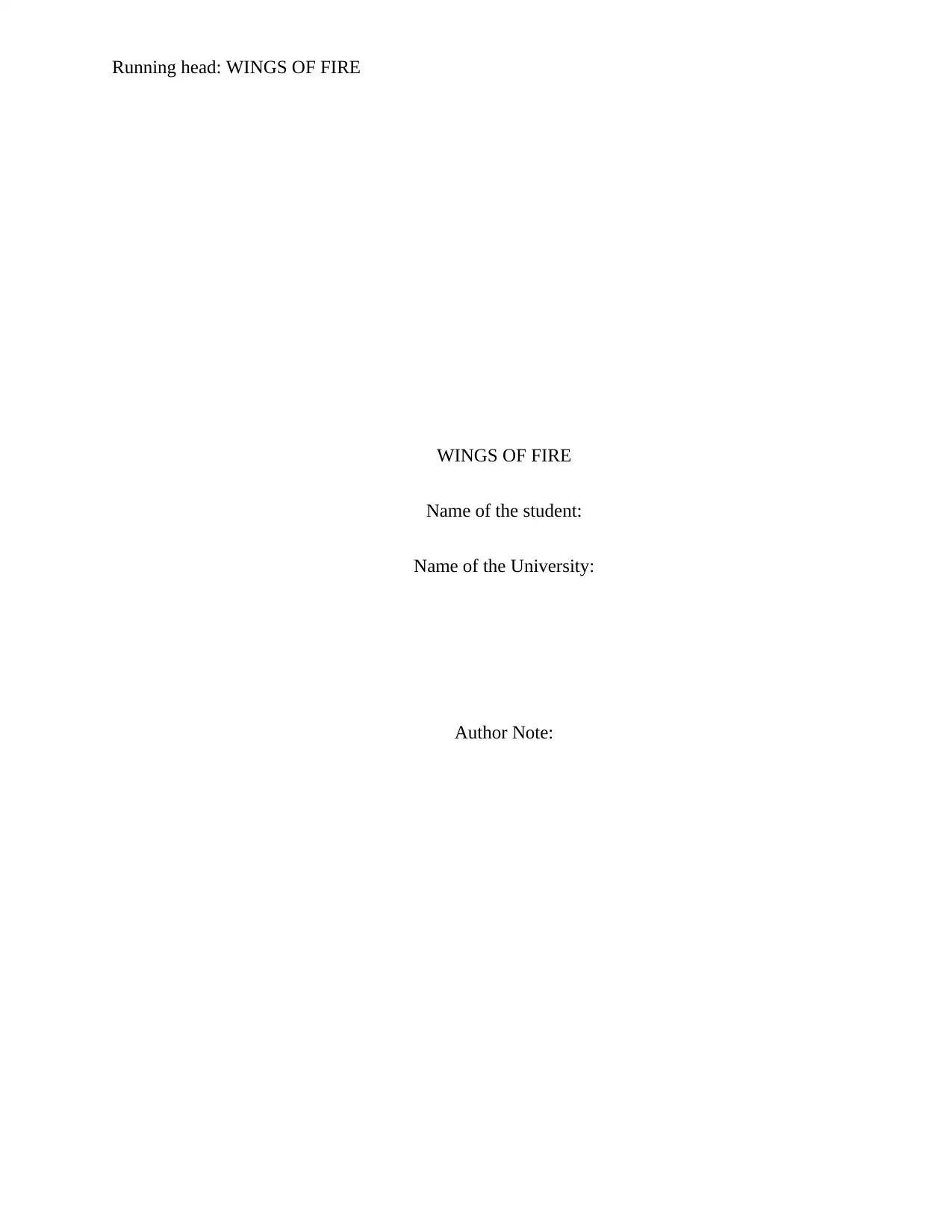
Running head: WINGS OF FIRE
WINGS OF FIRE
Name of the student:
Name of the University:
Author Note:
WINGS OF FIRE
Name of the student:
Name of the University:
Author Note:
Paraphrase This Document
Need a fresh take? Get an instant paraphrase of this document with our AI Paraphraser
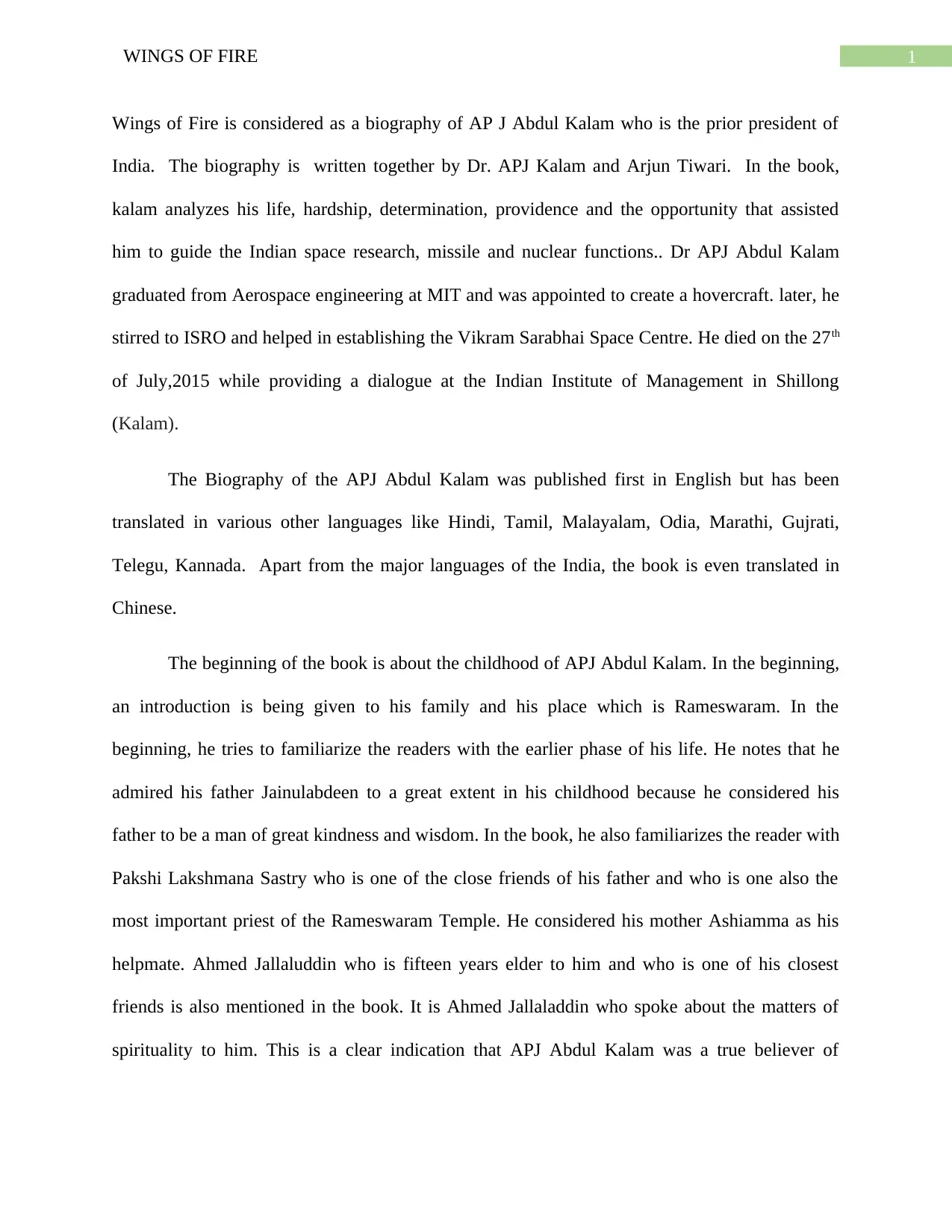
1WINGS OF FIRE
Wings of Fire is considered as a biography of AP J Abdul Kalam who is the prior president of
India. The biography is written together by Dr. APJ Kalam and Arjun Tiwari. In the book,
kalam analyzes his life, hardship, determination, providence and the opportunity that assisted
him to guide the Indian space research, missile and nuclear functions.. Dr APJ Abdul Kalam
graduated from Aerospace engineering at MIT and was appointed to create a hovercraft. later, he
stirred to ISRO and helped in establishing the Vikram Sarabhai Space Centre. He died on the 27th
of July,2015 while providing a dialogue at the Indian Institute of Management in Shillong
(Kalam).
The Biography of the APJ Abdul Kalam was published first in English but has been
translated in various other languages like Hindi, Tamil, Malayalam, Odia, Marathi, Gujrati,
Telegu, Kannada. Apart from the major languages of the India, the book is even translated in
Chinese.
The beginning of the book is about the childhood of APJ Abdul Kalam. In the beginning,
an introduction is being given to his family and his place which is Rameswaram. In the
beginning, he tries to familiarize the readers with the earlier phase of his life. He notes that he
admired his father Jainulabdeen to a great extent in his childhood because he considered his
father to be a man of great kindness and wisdom. In the book, he also familiarizes the reader with
Pakshi Lakshmana Sastry who is one of the close friends of his father and who is one also the
most important priest of the Rameswaram Temple. He considered his mother Ashiamma as his
helpmate. Ahmed Jallaluddin who is fifteen years elder to him and who is one of his closest
friends is also mentioned in the book. It is Ahmed Jallaladdin who spoke about the matters of
spirituality to him. This is a clear indication that APJ Abdul Kalam was a true believer of
Wings of Fire is considered as a biography of AP J Abdul Kalam who is the prior president of
India. The biography is written together by Dr. APJ Kalam and Arjun Tiwari. In the book,
kalam analyzes his life, hardship, determination, providence and the opportunity that assisted
him to guide the Indian space research, missile and nuclear functions.. Dr APJ Abdul Kalam
graduated from Aerospace engineering at MIT and was appointed to create a hovercraft. later, he
stirred to ISRO and helped in establishing the Vikram Sarabhai Space Centre. He died on the 27th
of July,2015 while providing a dialogue at the Indian Institute of Management in Shillong
(Kalam).
The Biography of the APJ Abdul Kalam was published first in English but has been
translated in various other languages like Hindi, Tamil, Malayalam, Odia, Marathi, Gujrati,
Telegu, Kannada. Apart from the major languages of the India, the book is even translated in
Chinese.
The beginning of the book is about the childhood of APJ Abdul Kalam. In the beginning,
an introduction is being given to his family and his place which is Rameswaram. In the
beginning, he tries to familiarize the readers with the earlier phase of his life. He notes that he
admired his father Jainulabdeen to a great extent in his childhood because he considered his
father to be a man of great kindness and wisdom. In the book, he also familiarizes the reader with
Pakshi Lakshmana Sastry who is one of the close friends of his father and who is one also the
most important priest of the Rameswaram Temple. He considered his mother Ashiamma as his
helpmate. Ahmed Jallaluddin who is fifteen years elder to him and who is one of his closest
friends is also mentioned in the book. It is Ahmed Jallaladdin who spoke about the matters of
spirituality to him. This is a clear indication that APJ Abdul Kalam was a true believer of
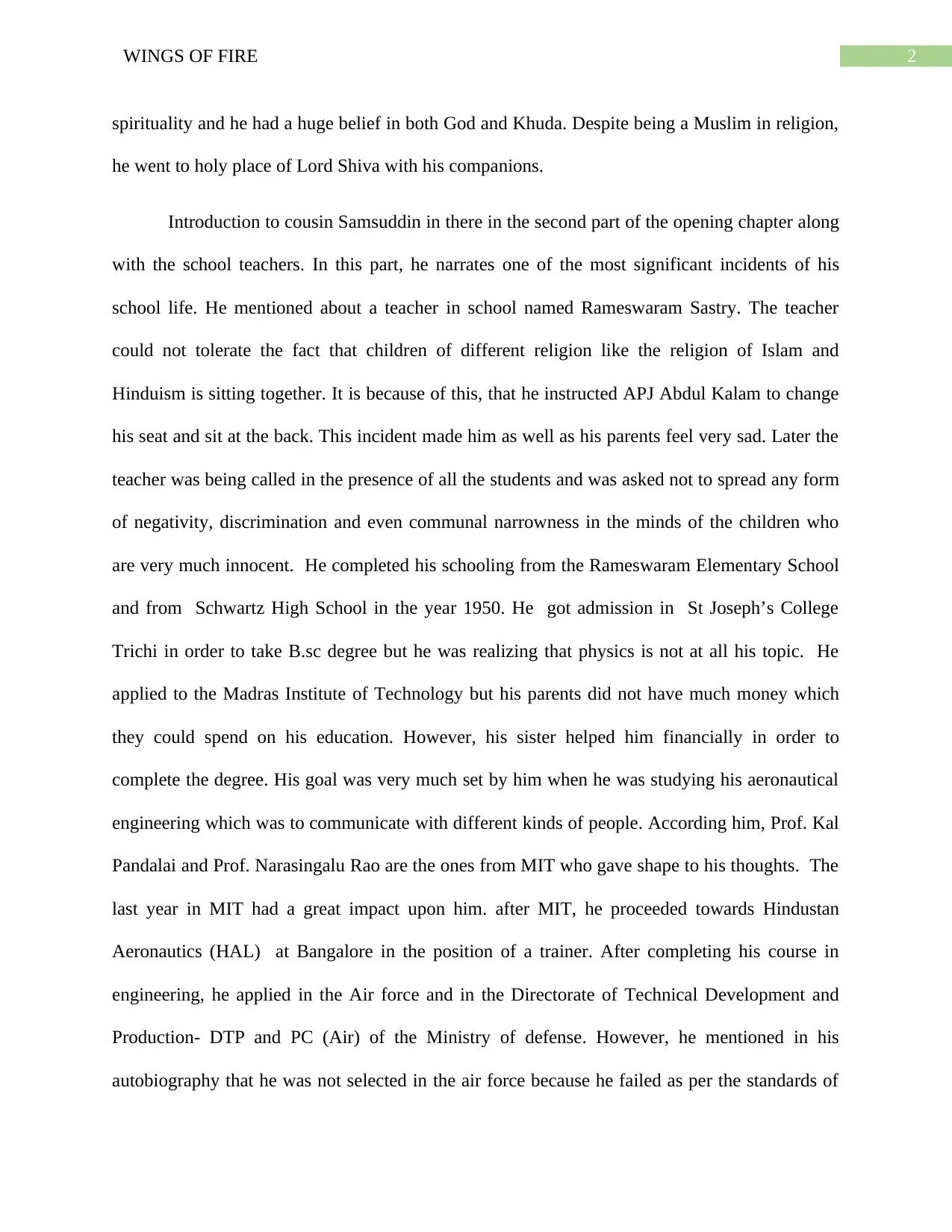
2WINGS OF FIRE
spirituality and he had a huge belief in both God and Khuda. Despite being a Muslim in religion,
he went to holy place of Lord Shiva with his companions.
Introduction to cousin Samsuddin in there in the second part of the opening chapter along
with the school teachers. In this part, he narrates one of the most significant incidents of his
school life. He mentioned about a teacher in school named Rameswaram Sastry. The teacher
could not tolerate the fact that children of different religion like the religion of Islam and
Hinduism is sitting together. It is because of this, that he instructed APJ Abdul Kalam to change
his seat and sit at the back. This incident made him as well as his parents feel very sad. Later the
teacher was being called in the presence of all the students and was asked not to spread any form
of negativity, discrimination and even communal narrowness in the minds of the children who
are very much innocent. He completed his schooling from the Rameswaram Elementary School
and from Schwartz High School in the year 1950. He got admission in St Joseph’s College
Trichi in order to take B.sc degree but he was realizing that physics is not at all his topic. He
applied to the Madras Institute of Technology but his parents did not have much money which
they could spend on his education. However, his sister helped him financially in order to
complete the degree. His goal was very much set by him when he was studying his aeronautical
engineering which was to communicate with different kinds of people. According him, Prof. Kal
Pandalai and Prof. Narasingalu Rao are the ones from MIT who gave shape to his thoughts. The
last year in MIT had a great impact upon him. after MIT, he proceeded towards Hindustan
Aeronautics (HAL) at Bangalore in the position of a trainer. After completing his course in
engineering, he applied in the Air force and in the Directorate of Technical Development and
Production- DTP and PC (Air) of the Ministry of defense. However, he mentioned in his
autobiography that he was not selected in the air force because he failed as per the standards of
spirituality and he had a huge belief in both God and Khuda. Despite being a Muslim in religion,
he went to holy place of Lord Shiva with his companions.
Introduction to cousin Samsuddin in there in the second part of the opening chapter along
with the school teachers. In this part, he narrates one of the most significant incidents of his
school life. He mentioned about a teacher in school named Rameswaram Sastry. The teacher
could not tolerate the fact that children of different religion like the religion of Islam and
Hinduism is sitting together. It is because of this, that he instructed APJ Abdul Kalam to change
his seat and sit at the back. This incident made him as well as his parents feel very sad. Later the
teacher was being called in the presence of all the students and was asked not to spread any form
of negativity, discrimination and even communal narrowness in the minds of the children who
are very much innocent. He completed his schooling from the Rameswaram Elementary School
and from Schwartz High School in the year 1950. He got admission in St Joseph’s College
Trichi in order to take B.sc degree but he was realizing that physics is not at all his topic. He
applied to the Madras Institute of Technology but his parents did not have much money which
they could spend on his education. However, his sister helped him financially in order to
complete the degree. His goal was very much set by him when he was studying his aeronautical
engineering which was to communicate with different kinds of people. According him, Prof. Kal
Pandalai and Prof. Narasingalu Rao are the ones from MIT who gave shape to his thoughts. The
last year in MIT had a great impact upon him. after MIT, he proceeded towards Hindustan
Aeronautics (HAL) at Bangalore in the position of a trainer. After completing his course in
engineering, he applied in the Air force and in the Directorate of Technical Development and
Production- DTP and PC (Air) of the Ministry of defense. However, he mentioned in his
autobiography that he was not selected in the air force because he failed as per the standards of
⊘ This is a preview!⊘
Do you want full access?
Subscribe today to unlock all pages.

Trusted by 1+ million students worldwide
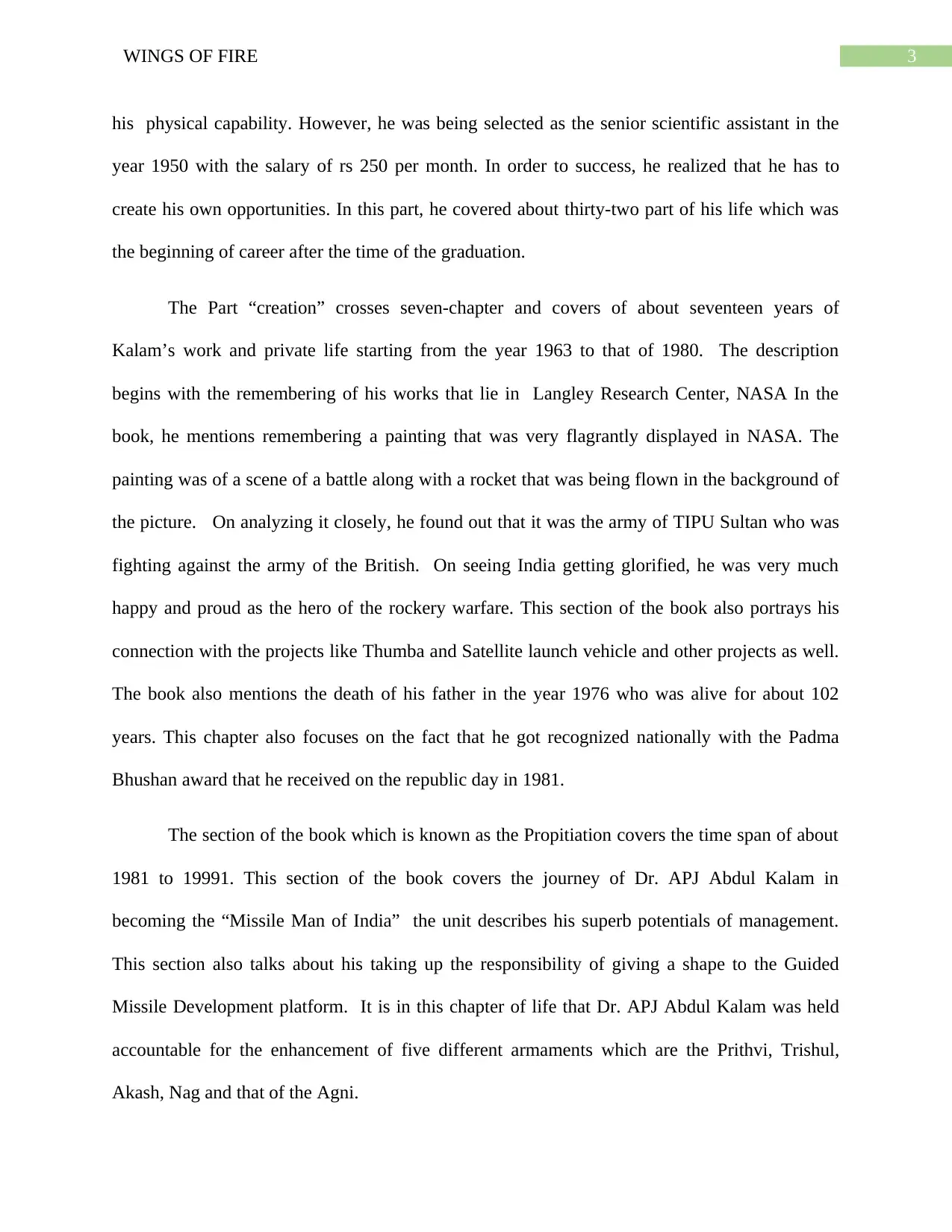
3WINGS OF FIRE
his physical capability. However, he was being selected as the senior scientific assistant in the
year 1950 with the salary of rs 250 per month. In order to success, he realized that he has to
create his own opportunities. In this part, he covered about thirty-two part of his life which was
the beginning of career after the time of the graduation.
The Part “creation” crosses seven-chapter and covers of about seventeen years of
Kalam’s work and private life starting from the year 1963 to that of 1980. The description
begins with the remembering of his works that lie in Langley Research Center, NASA In the
book, he mentions remembering a painting that was very flagrantly displayed in NASA. The
painting was of a scene of a battle along with a rocket that was being flown in the background of
the picture. On analyzing it closely, he found out that it was the army of TIPU Sultan who was
fighting against the army of the British. On seeing India getting glorified, he was very much
happy and proud as the hero of the rockery warfare. This section of the book also portrays his
connection with the projects like Thumba and Satellite launch vehicle and other projects as well.
The book also mentions the death of his father in the year 1976 who was alive for about 102
years. This chapter also focuses on the fact that he got recognized nationally with the Padma
Bhushan award that he received on the republic day in 1981.
The section of the book which is known as the Propitiation covers the time span of about
1981 to 19991. This section of the book covers the journey of Dr. APJ Abdul Kalam in
becoming the “Missile Man of India” the unit describes his superb potentials of management.
This section also talks about his taking up the responsibility of giving a shape to the Guided
Missile Development platform. It is in this chapter of life that Dr. APJ Abdul Kalam was held
accountable for the enhancement of five different armaments which are the Prithvi, Trishul,
Akash, Nag and that of the Agni.
his physical capability. However, he was being selected as the senior scientific assistant in the
year 1950 with the salary of rs 250 per month. In order to success, he realized that he has to
create his own opportunities. In this part, he covered about thirty-two part of his life which was
the beginning of career after the time of the graduation.
The Part “creation” crosses seven-chapter and covers of about seventeen years of
Kalam’s work and private life starting from the year 1963 to that of 1980. The description
begins with the remembering of his works that lie in Langley Research Center, NASA In the
book, he mentions remembering a painting that was very flagrantly displayed in NASA. The
painting was of a scene of a battle along with a rocket that was being flown in the background of
the picture. On analyzing it closely, he found out that it was the army of TIPU Sultan who was
fighting against the army of the British. On seeing India getting glorified, he was very much
happy and proud as the hero of the rockery warfare. This section of the book also portrays his
connection with the projects like Thumba and Satellite launch vehicle and other projects as well.
The book also mentions the death of his father in the year 1976 who was alive for about 102
years. This chapter also focuses on the fact that he got recognized nationally with the Padma
Bhushan award that he received on the republic day in 1981.
The section of the book which is known as the Propitiation covers the time span of about
1981 to 19991. This section of the book covers the journey of Dr. APJ Abdul Kalam in
becoming the “Missile Man of India” the unit describes his superb potentials of management.
This section also talks about his taking up the responsibility of giving a shape to the Guided
Missile Development platform. It is in this chapter of life that Dr. APJ Abdul Kalam was held
accountable for the enhancement of five different armaments which are the Prithvi, Trishul,
Akash, Nag and that of the Agni.
Paraphrase This Document
Need a fresh take? Get an instant paraphrase of this document with our AI Paraphraser
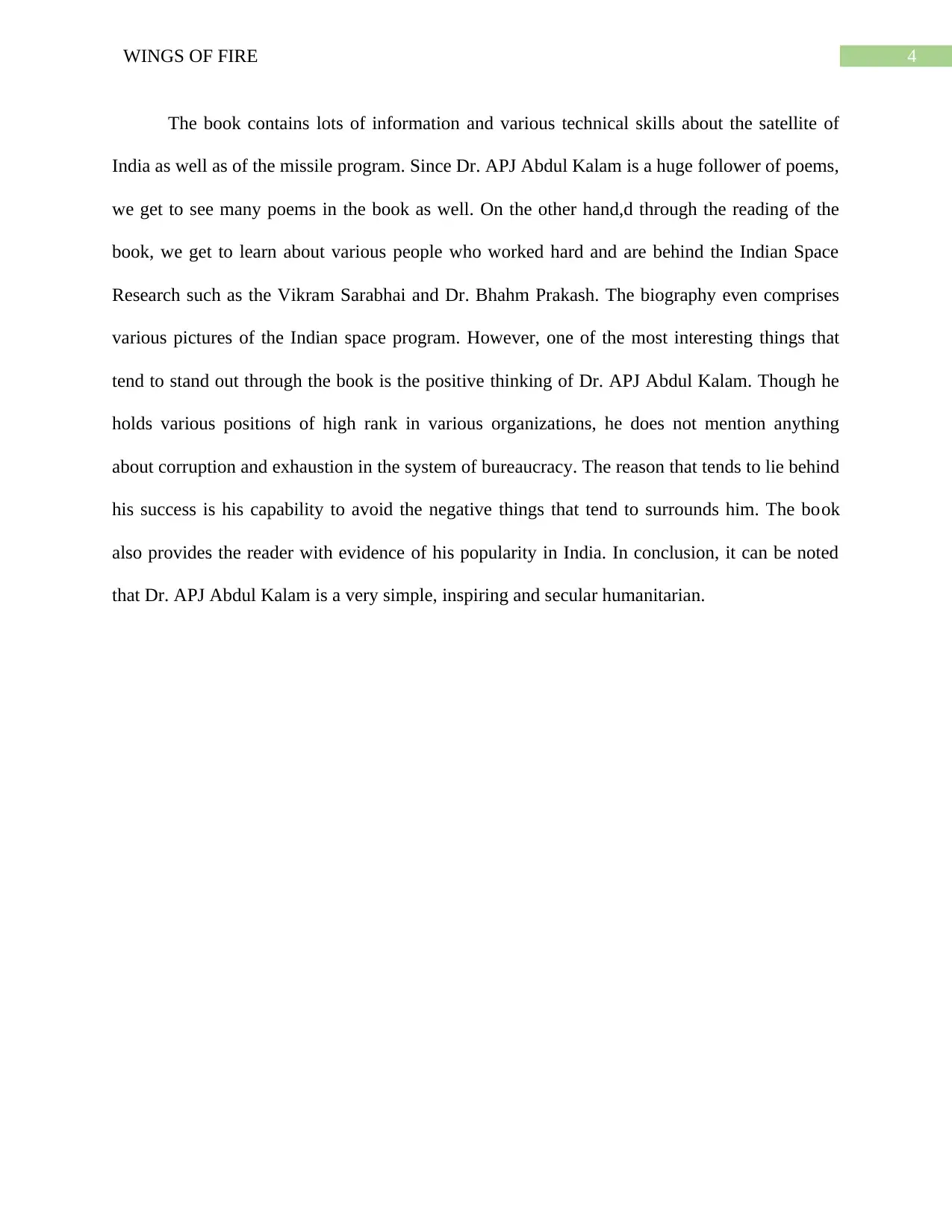
4WINGS OF FIRE
The book contains lots of information and various technical skills about the satellite of
India as well as of the missile program. Since Dr. APJ Abdul Kalam is a huge follower of poems,
we get to see many poems in the book as well. On the other hand,d through the reading of the
book, we get to learn about various people who worked hard and are behind the Indian Space
Research such as the Vikram Sarabhai and Dr. Bhahm Prakash. The biography even comprises
various pictures of the Indian space program. However, one of the most interesting things that
tend to stand out through the book is the positive thinking of Dr. APJ Abdul Kalam. Though he
holds various positions of high rank in various organizations, he does not mention anything
about corruption and exhaustion in the system of bureaucracy. The reason that tends to lie behind
his success is his capability to avoid the negative things that tend to surrounds him. The book
also provides the reader with evidence of his popularity in India. In conclusion, it can be noted
that Dr. APJ Abdul Kalam is a very simple, inspiring and secular humanitarian.
The book contains lots of information and various technical skills about the satellite of
India as well as of the missile program. Since Dr. APJ Abdul Kalam is a huge follower of poems,
we get to see many poems in the book as well. On the other hand,d through the reading of the
book, we get to learn about various people who worked hard and are behind the Indian Space
Research such as the Vikram Sarabhai and Dr. Bhahm Prakash. The biography even comprises
various pictures of the Indian space program. However, one of the most interesting things that
tend to stand out through the book is the positive thinking of Dr. APJ Abdul Kalam. Though he
holds various positions of high rank in various organizations, he does not mention anything
about corruption and exhaustion in the system of bureaucracy. The reason that tends to lie behind
his success is his capability to avoid the negative things that tend to surrounds him. The book
also provides the reader with evidence of his popularity in India. In conclusion, it can be noted
that Dr. APJ Abdul Kalam is a very simple, inspiring and secular humanitarian.

5WINGS OF FIRE
References
Kalam, A.P.J. and Kalam, A.P.J., 1999. Wings of fire. University Press.
References
Kalam, A.P.J. and Kalam, A.P.J., 1999. Wings of fire. University Press.
⊘ This is a preview!⊘
Do you want full access?
Subscribe today to unlock all pages.

Trusted by 1+ million students worldwide
1 out of 6
Your All-in-One AI-Powered Toolkit for Academic Success.
+13062052269
info@desklib.com
Available 24*7 on WhatsApp / Email
![[object Object]](/_next/static/media/star-bottom.7253800d.svg)
Unlock your academic potential
Copyright © 2020–2025 A2Z Services. All Rights Reserved. Developed and managed by ZUCOL.